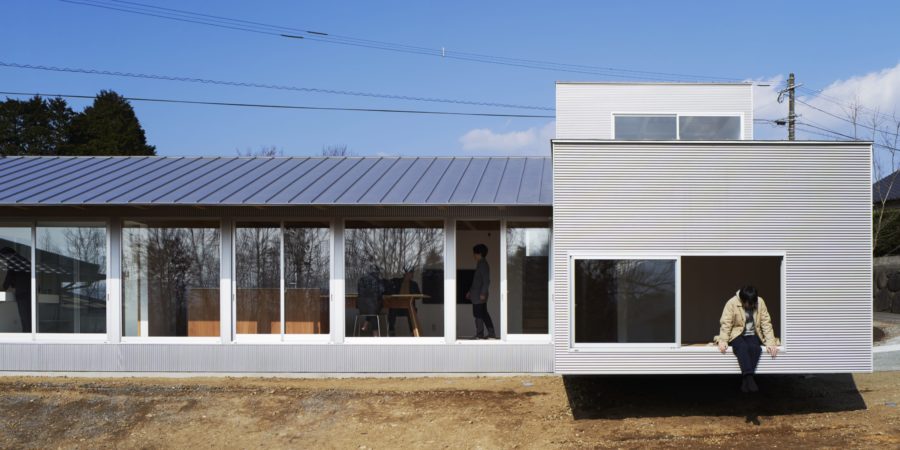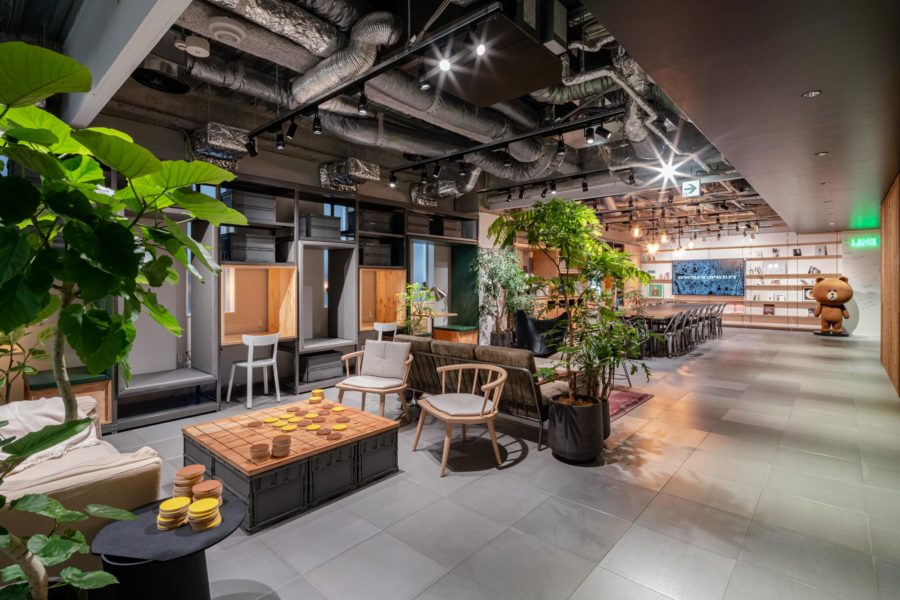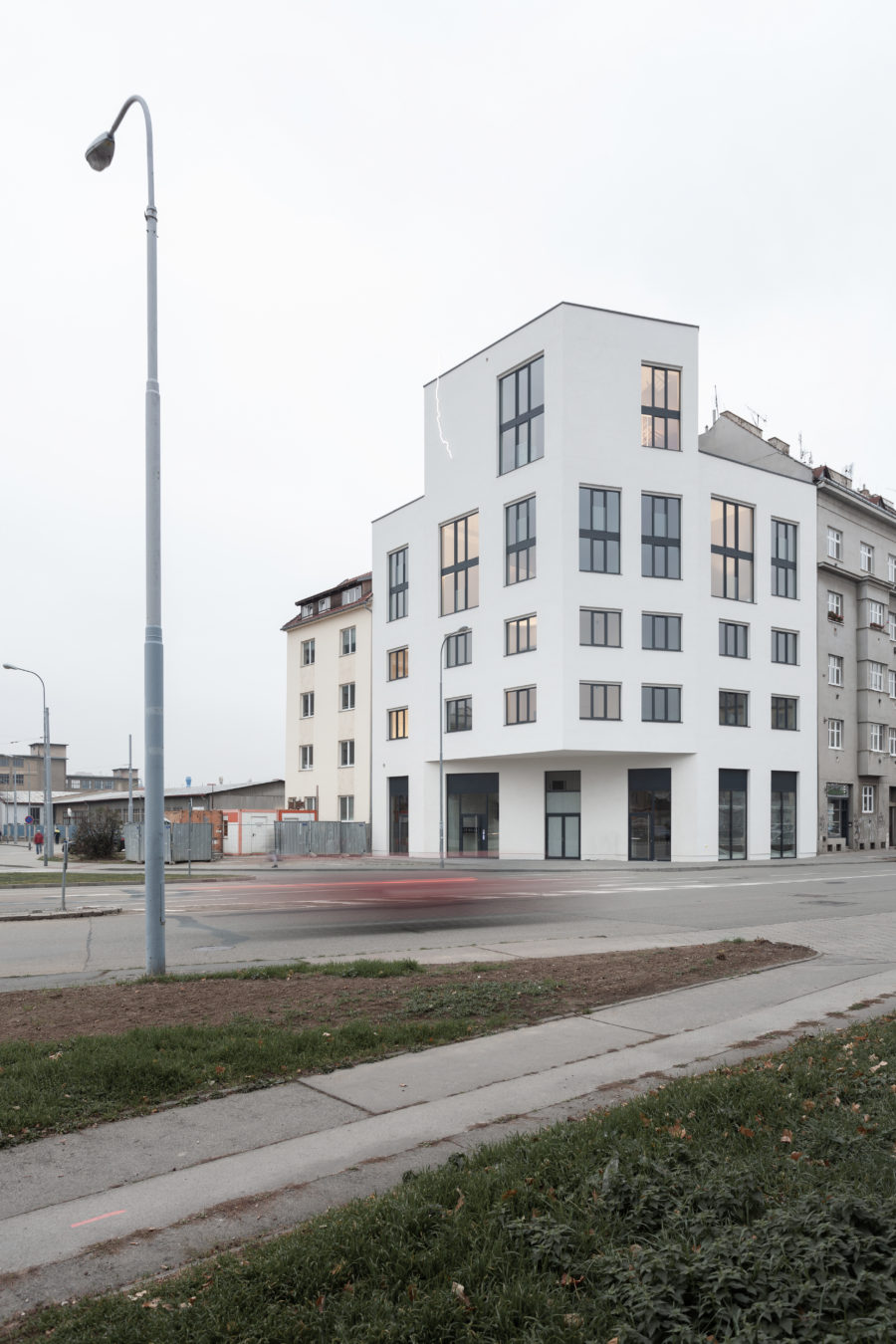敷地は大阪府東大阪市の中心部から少し離れた寺を中心とする場所で、古い民家や商家が多く残されている地域でもある。今回の敷地は埋蔵文化財包蔵地に該当し、日本の長屋的な住宅が密集している地域であった。
当初施主の要望は明確で、「シンガポールのプラナカン建築の風景」といった異国情緒を住宅に求められており、間取りやファサードにもしっかりとしたイメージを持たれていた。そのため、設計当初はプラナカン建築の要素を取り入れ、施主のイメージするような案からアプローチしていたが、どうも施主が求められている本質との乖離を感じ始めた。
そこでコンセプトとしては、日本の長屋にプラナカン建築のピロティのイメージを取り込む仕掛けを考えた。プラナカン建築は、日本の長屋のようにお互いに隣地の建物が寄り添いながら、建物前面のポーチ空間と袖壁のアーチが隣地同士で連続することによって、1つのアーケードとしての景観をつくっている。
このイメージで、建物をエントランスから建物奥につれて天井高が高くなるように計画、一部を2階建てとして建物の立体感をもたせた。前面道路から、エントランス、前庭、LDK、中庭、ユーティリティ、寝室といったように段階的にゾーニングするとともに、またそれらを隔てる欄間部分をアーチ状にした。
そのアーチは大きさをリズムよく変化させながら、建物奥に向かってレイヤとして重なり陰影が生まれることでさらなる奥行き感が生まれた。
室内でもプラナカン建築のピロティをくぐり抜けていくような期待感や、外部との繋がりを感じられる空間とし、アーチの一部を切り取るようなデザインにすることで、視覚的な工夫をし、広がり感をつくり出している。
外部との空間構成については、長屋のように建ぺい率いっぱいに構えながら、その中に前庭や中庭を介在させた。それによってパブリックな外部空間とプライベートな内部空間を柔らかく繋ぎ、空を取り込む縦方向に抜ける開放感があることで、季節や時間によって移り変わる自然光を感じ、豊かな広がりや動きを実現した。また、ファサードや中庭を構成する外壁は、キャンチレバーによる足元の隙間からの風も感じられる。
造園については、濃い緑や大きめの葉など、南洋植物のイメージで計画することによって、建物のコンセプトと調和し、季節ごとに彩りや変化が楽しめる暮らしのアクセントとしている。
室内空調・温熱環境については、人も建築も健康であってほしいと考えていることから、壁や天井を自然素材由来の左官風仕上げとし、調湿効果を高め、素材感を楽しめる計画とするとともに、断熱材は木造用の吹付け断熱材とし、サッシは複層ガラス(一部真空ガラスを採用)として断熱性を高めた。加えて、外気の不純物を除去するフィルターを介した第2種換気を採用し、住宅の隅々までクリーンな空気の循環が生まれるよう計画した。
今回の計画は築年数の経つ隣接する長屋から切り取り、建て替えた。異国の建築要素を再解釈したアーチや、前庭と中庭を介在させることによって新たな息吹をもたらせた。光や風、季節のうつろいなど日々の変化もしっかりと感じられる住宅である。シンプルながらも異国情緒のエッセンスが入った日常を心地よく過ごされ、豊かな心が育まれることを願う。(堤 庸策+梅崎裕子)
An exotic house with an arch and two gardens
The site location is a bit far from the center of Higashi-Osaka city, Osaka prefecture, where temples are in the city’s center, old residential houses and stores still remain. This region is located in a buried cultural property, among a dense residential area of Japanese-style row houses.
At the start of the design process, the request of the client was clear, they preferred “Singapore’s Peranakan architectural features,” in other words, an extraordinary atmosphere for the house, and furthermore, they had a clear image of room location and façade. For this reason, at first, taking Peranakan architectural elements into the design, creating a plan which the client requested, in spite of this approach, the distance from the real taste of the client request got expanded.
Therefore, the concept was created in a way that the Peranakan architectural pilotis element is incorporated with Japanese-style row houses. The Peranakan architecture features a landscape as an arcade by connecting the front space of porches of buildings and the sidewall arches together in a row.
For this image, the height of the wall is getting high from the entrance to the back of the house. Some parts of the house are built in two-story buildings to have a three-dimensional effect. From the front road, entrance, front yard, living-dining-kitchen, courtyard, utility room, bedroom, in this order, rooms are designed, and the partitions were made with arches.
The size of the arches varies rhythmically, and to the back of the house, its layers are overlapped. This setting makes the shadows in the space, adding depth to the whole house image.
Inside the rooms, there is a sense of expectation as if passing through the pilotis of Peranakan architecture, a space where one can feel the connection with the outside, the design which is as if cutting a part of arches produces a sense of openness with this efficient visual effect.
As for the space structure with the outside, the house is built in a maximum building coverage ratio like a row house, and a front yard and a courtyard are set inside. These yards connect softly between the outside space and the private inside space, a sense of openness going through vertically from the sky, feeling the natural sunlight along with seasons and time, which in effect creates a profound openness and moves. In addition, the exterior walls consisting of the façade and the courtyard let the wind through the gaps in the feet because of the cantilever.
For landscaping, the design is created by using southern plants such as dark green and large leaves, harmonizing with the concept of the house. This is an accent of living where one can enjoy the colors and the changes in each season.
Regarding interior ventilation and heat insulation, by the concept that wishing the residents and the building would be equally healthy, the walls and the ceiling are made in a natural material, plaster-oriented finish, having the high effect of adjustment, enjoying the taste of materials at the same time. As for the heat insulation, wooden sprayed insulation is chosen, the sash is created with multi-layered glass (partly using vacuum glass) to improve thermal insulation performance. Plus, The second type of ventilation system is selected, which removes impurities from the outside air through a filter. This enables clean air to circulate through to every corner of the house.
This plan was created by cutting and rebuilding an aged adjacent row house. This house was reborn by reinterpreted exotic architectural elements arches, the front yard, and the courtyard. Light, wind, and the daily changes of the seasons can be felt firmly in this house. A comfortable daily life would be spent by the residents, adding an essence of simple but exotic elements and hoping this environment would cherish their hearts richly. (Yousaku Tsutsumi + Yuko Umesaki)
【House in Ohasu】
所在地:大阪府東大阪市
用途:戸建住宅
クライアント:個人
竣工:2019年
設計:arbol
担当:堤 庸策+梅崎裕子(アトリエM.A.R.)
作図協力:宮本善州建築設計事務所
空調設備:ジェイベック
照明設備:大光電機
造園:GREEN SPACE
施工:岩鶴工務店
撮影:下村康典
工事種別:新築
構造:木造
規模:地上2階
敷地面積:70.80m²
建築面積:41.26m²
延床面積:59.48m²
設計期間:2017.09-2019.02
施工期間:2019.03-2019.07
【House in Ohasu】
Location: Higashiosaka-shi, Osaka, Japan
Principal use: Residential
Client: Individual
Completion: 2019
Architects: arbol
Design team: Yousaku Tsutsumi, Yuko Umesaki / Atelier M.A.R.
Drawing: Yoshikuni Miyamoto
Air conditioning: JBECK
Lighting design: Daiko Electric
Landscape: GREEN SPACE
Contractor: IWATSURU CONSTRUCTION
Photographs: Yasunori Shimomura
Construction type: New building
Main structure: Wood
Building scale: 2 stories
Site area: 70.80m²
Building area: 41.26m²
Total floor area: 59.48m²
Design term: 2017.09-2019.02
Construction term: 2019.03-2019.07








